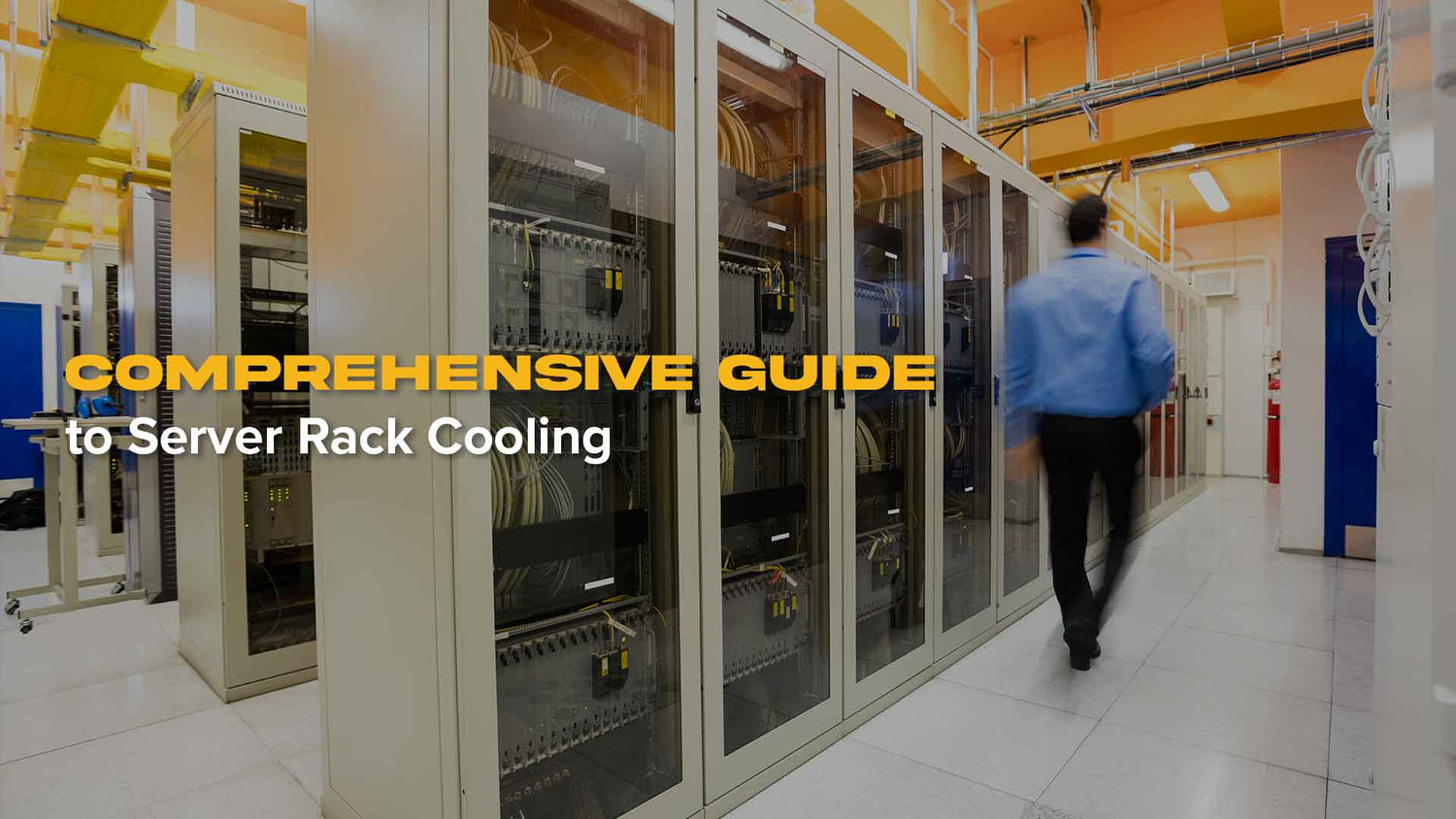When it comes to data centers and server rooms, server rack cooling is one of the most important aspects in ensuring the smooth operation of the center. As businesses and organizations rely more on larger and more complex IT infrastructures, the need to maintain temperatures in server racks has become ever more urgent. Overheating can generate failures of equipment, slow down performance, or cause loss of data. Hence, knowledge of the various server rack cooling methods and technologies is very important.
This guide looks into the system of server rack cooling in detail; the analysis of various strategies and products is provided to ensure servers are guaranteed to be at the temperature best for performance.

The Importance of Server Rack Cooling
Server racks protect several critical IT equipment: servers, switches, routers, and various other networking devices. These machines generate considerable amounts of heat, and this heat build up creates serious problems if not kept cool. Hence, cooling in server racks is a must and not an option. Considerable overheating can also affect the rack in some ways:
Hardware Damage
Excessively hot air inside the server rack can lead to permanent damage to very delicate hardware components like motherboards, CPUs, and HDDs. Overheating can warp solder joints, erode microchips, and create electrical shorts all of which cause the computer to fail. Hard disks, highly sensitive to temperature variations, can be subject to data corruption or mechanical failure where excessive heat exists. In this way, equipment becomes more susceptible to damage, and they will certainly fail in a shorter duration, making replacements expensive and leading to probable data losses.
Lower Performance
Whenever the servers undergo overheating, they enter the thermal throttling mode; purposely lowering the performance level would avoid further damage. Although such a protective mode helps sustain hardware from overheating and damage, it, however, allows the server to slow down beyond acceptable limits. This slowdown affects overall system operation, including delays in processing and slow response time. In scenarios where high performance is needed, such as in data analysis or huge scale computing, the slowdowns present issues that paint a negative picture in terms of user experience and overall business.
System Downtime
When a server exceeds the unsafe temperature limit, it will simply shut itself down in order to protect the system hardware from damage. While this is a good safety feature, such incidence leads to unplanned system downtime. During this period, critical services and applications may be unavailable, thereby disrupting business activities. Such unproductive downtime is likely to lead to huge financial losses for businesses that rely on constant server uptime, such as e-commerce or financial institutions, and may also reduce productivity while hurting their reputation. Unwanted shutdowns as a result of constant overheating increase the chance for the system to be unstable in the long run.
Different Cooling Methods for Server Racks
There are a number of different cooling methods to control the temperature inside a server rack. The chosen cooling method depends on factors like the server room size, type of servers used, and energy efficiency targets.
1. Passive Cooling
Passive cooling works by natural airflow supplied to cool the servers. The assignment is such that the server room must be well ventilated and could easily let the escape of hot air escape. This type of cooling is usually confined within small places or areas where heat is produced at minimum levels. However, the passive method is often inadequate in larger server racks containing several operating units.
2. Active Cooling
Active cooling uses mechanical devices such as fans or air conditioners to force air into the server rack and extract heat. Typically, this method caters best to large server environments as it provides a more effective consistency and reliability of cooling source.
Active cooling systems come in several forms:
Airflow management: This would include optimizing the arrangement of servers within racks so that better airflow can be obtained. The use of blanking panels to fill up the gaps and ensuring the cold and hot aisles are well defined should improve the efficiency of the system.
Cooling fans: The correct placement of cooling fans in the server rack can increase airflow and maintain temperature. These will assist in blowing smoking hot air out of the server rack while at the same time drawing in cooler air from the general vicinity to help cool the servers.
3. Liquid Cooling
Liquid cooling is in many cases the most effective of all solutions for high performance computing. Coolants are routed through lines attached to the server hardware and take heat from it, usually transporting the heat to a heat exchanger or radiator.
While requiring a much higher investment at the outset, liquid cooling is extremely efficient and is mostly used in high density server environments, where traditional air based cooling may not be sufficient.

Rack Cooling Solutions: Key Components
Of all aspects which keep a server rack cool, the integration of numerous components comes together to make sure effective cooling. Here are the few components involved in establishing the comprehensive solution to achieve server rack cooling.
Fan Modules for Server Rack Cooling
The most common practice of cooling a server rack is to employ the fan modules designed specifically for server rack integration. These modules ensure proper air circulation over the entire servers.
Modern fan modules for server racks can be classified according to designs such as horizontal, vertical, or top mounted. These are provided with a high performance fan as part of the fan module that can generate a strong airflow to quickly remove hot air and supply cooler air from the room. Therefore, these fan modules are significant in ensuring that there are no hotspots within server racks and that all equipment is kept cool.
The key benefits of fan modules for server rack cooling include:
● Ease of Installation: Fan modules are often very easy to install without major modification in an existing server rack.
● Energy Efficiency: Newer models fan modules have incorporated with the designs towards energy efficient consumption for effective cooling in the business.
● Customization: Fan speeds and configurations are made available in accordance with server environment specific needs
Cooling Fans for Server Racks
Cooling fans for server racks are indispensable for cooling servers. Ideally mounted inside the rack or on the side panels of the rack are designed to direct airflow through the servers, dissipating heat.
They either blow cold air over components or draw away warm air from the assembly depending upon the design, cooling fans for server racks are usually available in varieties of sizes and types customized for the many types of servers.
The key considerations when selecting cooling fans for server racks include:
Noise levels: Some cooling fans can be excessively loud and noisy especially in high performance levels, selecting fans with less noise ratings helps ameliorate the setting of operation.
Airflow rate: The airflow capacity of the fan becomes very essential. It's required to be quite good to remove the heat generated by the server, but not very high so that it creates turbulence causing disturbance in the equipment.
Durability: Fans should be made durable and robust in order to resist wear and tear so that no continuous replacements are required, particularly under conditions where cooling is critical.
Best Practices for Server Rack Cooling
Here are some tips on how to maximize cooling efficiency, which requires more than just proper equipment:
1. Right Airflow Design
A good airflow system is the best preventive measure against heat accumulation. Cold air is directed into the servers from the front with warm air exiting from the back by running cold aisle and hot aisle containment systems. This arrangement ensures that hot and cold airflows are separated.
2. Regular Maintenance
Routine maintenance of cooling systems helps ensure that fans, air conditioning units, and other appliances continue to operate at peak performance. Cleaning dust off fans and filters, checking for obstructions, and monitoring airflow are simple yet important tasks that further the ends of maintaining appropriate cooling.
3. Temperature Monitoring
Using temperature sensors within the server racks can provide real time data on how well the cooling system is working. If the temperature exceeds acceptable levels, it becomes possible to address problems before they result in hardware failure or system downtime.
4. Scalability
It's an easy choice for server racks and cooling systems because, depending on the other additional servers added to the environment as a company grows, so will the IT infrastructure. This should keep overhead issues from growing and ensure the cooling system remains effective as the workload increases.
Effective cooling of server racks should ensure longevity and reliability in IT infrastructures. Organizations should opt for advanced liquid cooling systems or simple cooling fans for server racks. Proper research should be done to find the best solution that suits a company's needs. Investing in the right rack cooling strategies and technologies will ensure that organizations have their servers running at optimal temperatures, minimizing downtime and extending the lifespan of equipment.

Frequently Asked Questions (FAQ)
- What to consider when choosing a server rack cooling system?
The most important aspect of selecting a server rack cooling system is considering the following factors the size of the server room, the specific types of servers in use, energy efficiency targets, as well as the system's scalability. Furthermore, while active cooling systems generally work well in larger environments, passive cooling is appropriate for smaller spaces and lower heat generation.
- How do I choose the right cooling fans?
When it comes to cooling fans, things like noise level, airflow capacity, and durability should be taken into account. While powerful fans may be able to furnish the best airflow, they might also be too noisy. One must then balance between finding fans with appropriate airflow but keeping noise to a minimum. Shortening redundant replacement times would make owning fans that wear and tear resistant an added bonus.
- How can I scale my server rack cooling system?
However, as IT expands, the need for cooling can also increase. Adding more servers should mean that the cooling system easily accommodates this additional heat load. The really good cooling systems should be flexible, the scalable types such that it becomes very easy to upgrade as infrastructure expands.
- Why is regular maintenance of the cooling system important?
In optimal performance, maintenance of the cooling system ceases being an option to become a necessity. Dust itself accumulates on the fans and filters, restricting airflow as well as efficiency. Intermittent maintenance identifies problems, prevents many of them, and ensures that the cooling system functions effectively and keeps servers cool.
- What cooling method is the most efficient for server racks?
In high performance environments, liquid cooling is generally the most efficient solution. Compared to air based methods, liquid cooling systems have several advantages since they can use liquid mediums to remove heat more effectively. However, the initial investment is higher. For smaller and less demanding setups, active cooling (fans and air management) would suffice and also be cost effective.




Leave a comment
This site is protected by hCaptcha and the hCaptcha Privacy Policy and Terms of Service apply.